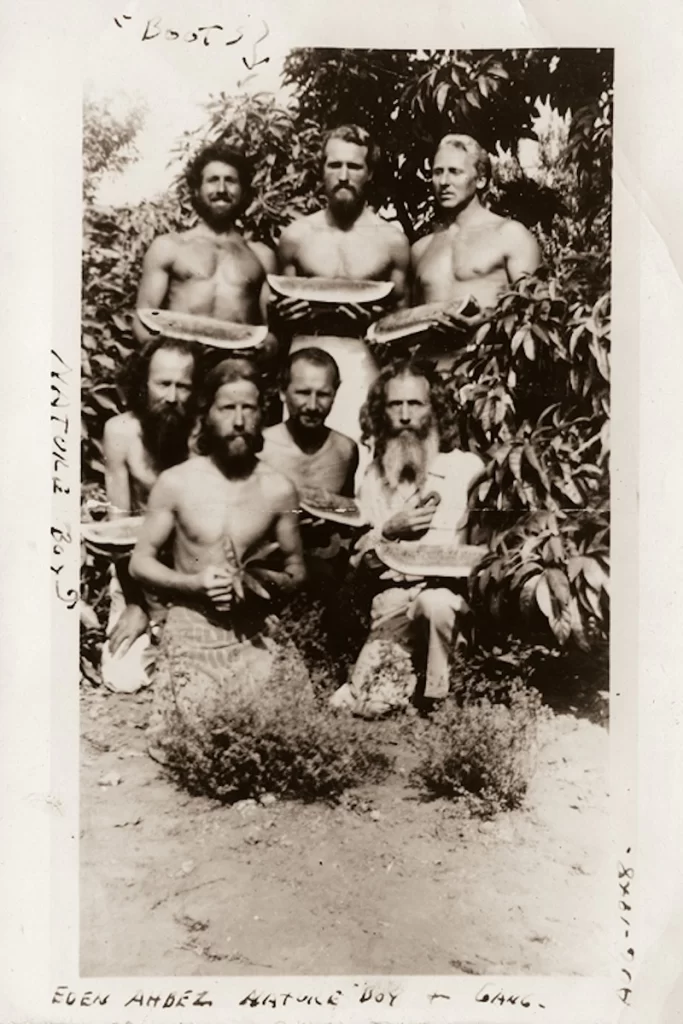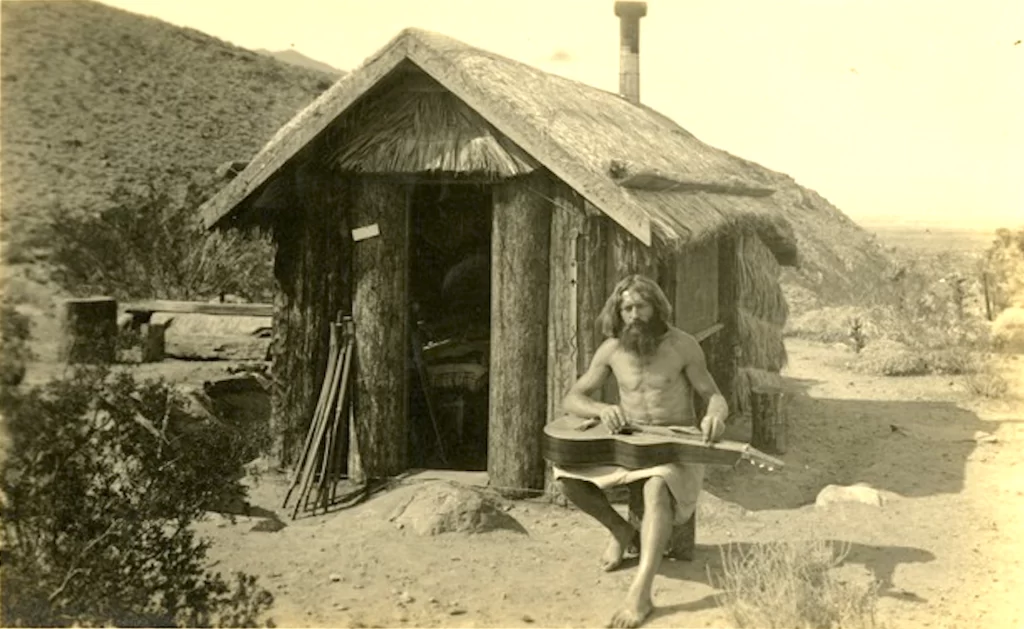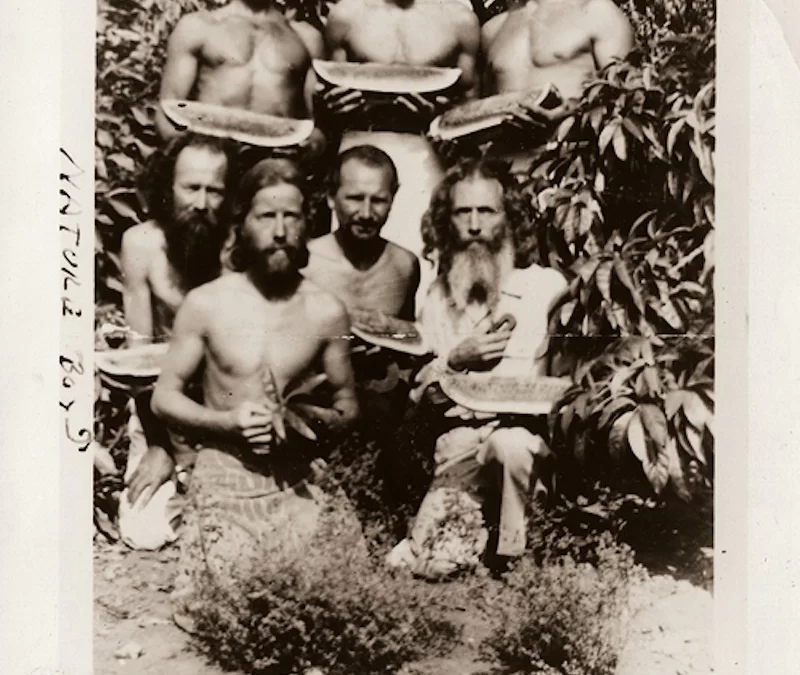
Welcome to a new monthly column from Los Angeles cultural historian Emmeline Summerton. Lost Canyons LA explores the evocative siren call that has been bringing newcomers to the Santa Monica Mountain region for more than a century and shares the stories of people seeking adventure, creativity, and new ways of living in this unique oasis of nature and beauty. In our first column we’ll travel back to some of the earliest arrivals to push the boundaries of a new way of life.
The Nature Boys of the 1930s and 1940s turned their backs on the rules of modern society and embraced a natural living philosophy, some 35 years before the 1960s hippy movement, and the young people who would later flock to the LA canyons.
The Nature Boys were influenced by “Lebensreform,” a European social reform movement that included a back-to-nature philosophy that was brought to California in the early 1900s by supporters of the movement. According to Gordon Kennedy, author of the definitive book on the Nature Boys, Children of the Sun, the most famous of these new arrivals was Bill Pester, who moved to California in 1906 and made his camp in Palm Canyon. A so-called “naturmenschen” or nature man, Pester soon attracted the attention of young Americans curious about his way of life. These new Nature Boys grew their hair and beards long, believed in an outdoor lifestyle, eating a raw, vegetarian diet and the spiritual teachings of early gurus such as Krishnamurti and Yogananda.
One of the first Nature Boys to gain notice in LA was Peter Howard, later known to all as “Peter the Hermit.” Howard was one of the most famous local characters during the golden age of Hollywood and the first person to make money posing for photos with tourists along Hollywood Boulevard. While not a disciple of Bill Pester, Howard embraced many of the Lebensreform and naturmenschen philosophies and lived in a small camp, tucked away in the Hollywood Hills, surrounded by his dogs, chickens and a donkey. With his long beard, flowing robes and the tall staff he carried, he looked like a character from the Old Testament and soon became a fixture in Hollywood, attracting the attention of everyone from the burgeoning tourist trade to film industry types.

In the mid-1920s, Howard had his first cameo in the film Souls of Bondage and over the years appeared in many more films as well as several newspapers and magazine articles. According to The LA Daily Mirror, Mae West mentioned in an interview that he was the man she most wanted to meet in Hollywood. Merchandise bearing his likeness was even sold in tourist shops near Grauman’s Chinese Theatre. The development of new housing pushed Howard out of his little spot in the hills in 1931 but, with the help of friends in the film industry who raised $500, he was able to build a small shack near Lookout Mountain in Laurel Canyon. Peter the Hermit continued to work up and down Hollywood Boulevard for nearly 40 more years before dying at age 90 in 1969.
By the late 1940s, Nature Boys were a fairly common sight in LA, particularly in the canyons. In his seminal book On the Road, Jack Kerouac writes that while his main character is traveling through the city in 1947, he’d see “an occasional Nature Boy saint in beard and sandals.” Most notable among the group at this time was musician eden ahbez (who styled his name without capitals) who had been a follower of Bill Pester and often performed at early vegetarian restaurant the Eutropheon in downtown LA. The restaurant was at the epicenter of the Nature Boy movement and was owned by Lebensreform followers Vera and John Richter.
The Richters ran several raw and vegan restaurants in LA as early as 1919 and employed many Nature Boys to work and play music there. Jack Patton, who became ahbez’s manager, once said, “the Eutropheon was the torch where they lit their lamp.”
Like Peter the Hermit, ahbez lived for a time in the Hollywood Hills, setting up a small camp below the first L of the Hollywood Sign. A prolific songwriter, ahbez reportedly wrote over 1,000 songs including one, “Nature Boy,” that would become a number one hit for Nat King Cole in 1948. The story goes that ahbez left a copy of the sheet music with Cole’s valet after a performance at the Lincoln Theater. Liking what he saw, Cole decided he wanted to record the song and had his manager track down ahbez at his camp to secure the music rights. The song spent 15 weeks at the top of the charts and brought ahbez to the attention of the media who were delighted to discover it was written by a “longhaired, bearded mystic who wore no shoes.”
One of the Nature Boys’ biggest contributions to Los Angeles life was through the numerous vegetarian restaurants that sprang up in the city from the 1940s to the 1960s. Following in the steps of the Eutropheon was The Source on the Sunset Strip. It was owned by Jim Baker. A World War II veteran who moved to LA in the 1940s and became involved in the Nature Boy movement. He also became a Vendanta monk and a disciple of Kundalini yoga. By 1969, The Source had become a huge hit with those seeking to explore spirituality and vegetarian lifestyles, along with the rockstar-types living in the surrounding canyons and hills. The restaurant was famously parodied by Woody Allen in his 1977 movie Annie Hall, where he is seen ordering “alfalfa sprouts and mashed yeast.”
Before long, customers began to turn to Baker for his spiritual guidance too and so, with a community of followers growing around him, Baker created a communal spiritualist home in the Los Feliz hills dubbed “The Mother House” in 1972. Around the same time, Baker began taking on multiple “spiritual wives” and eventually was married to 14 women at once, saying “Spiritual law preceded man’s law.” In 1973, the group moved to a three-bedroom ranch house in Nichols Canyon called “The Father House” and Baker took on the name Father Yod.
Eventually more than 140 people were living at the house, sleeping on floor-to-ceiling bunk beds and outside platforms. In her 2007 memoir, Source member Isis Aquarian said they were received with concern by their new neighbors. “I imagine the sight of a hundred young people living in one house, all wearing white and following around a man who looked like Moses, might have made some neighbors nervous,” Aquarian writes. “We were kind to everyone and kept the house immaculate, but we were up at 3:30 a.m. every morning for meditation, played music, and liked to walk around nude, among other things.” Father Yod and several followers also started their own psychedelic rock band called YaHoWha 13 who sold their records at the restaurant. After overstaying their welcome in Nichols Canyon, the Source community eventually left for Hawaii a few years later.
By the late 1960s, older Nature Boys could still be found at health food stores and music festivals around Los Angeles, and some became mentors to the new young people flocking to the canyons. However, the hedonistic alcohol and drug use of these new hippies didn’t always gel with the lifestyle practiced by their elders. One of these mentors was Robert Bootzin, known to everyone as Gypsy Boots, a well-loved Nature Boy from the 1940s scene who had befriended eden ahbez at the Eutropheon restaurant and later became an advocate for vegetarianism through television guest spots. Boots appeared on shows like You Bet Your Life in the 1950s and The Steve Allen Show in the 1960s, where he would swing onto the stage on a rope and persuade Allen to help him make organic juices and do exercises with him. In one episode, Boots served Allen one of his blended fruit drinks which he referred to as a “smoothie,” way before it became the drink of choice for just about every health-conscious person in the 21st century. Like others in the movement, Boots also opened an organic vegetarian restaurant and grocery store in the late 1950s, the Back to Nature Health Hut in West Hollywood. Such was Boots’ popularity that he appeared in several movies, including the Michael Douglas film The Game. Boots was also known for selling his products door-to-door and promoting his fitness classes and health foods at markets and fairs like Topanga Days, using his tagline “Don’t panic, go organic; get in cahoots with Gypsy Boots.”
Passing on their knowledge and wisdom in life, spirituality and health, the Nature Boys left an indelible mark that is still felt in the LA canyons today. What a legacy to leave behind!
Please join Lost Canyons LA next month for more stories from the canyons.













